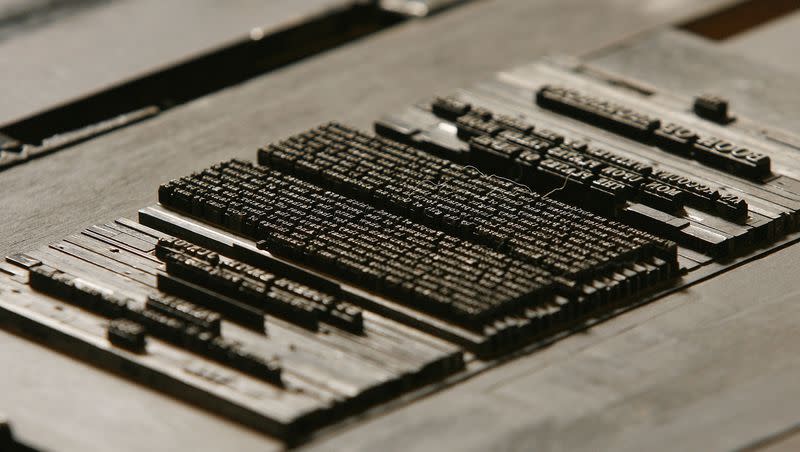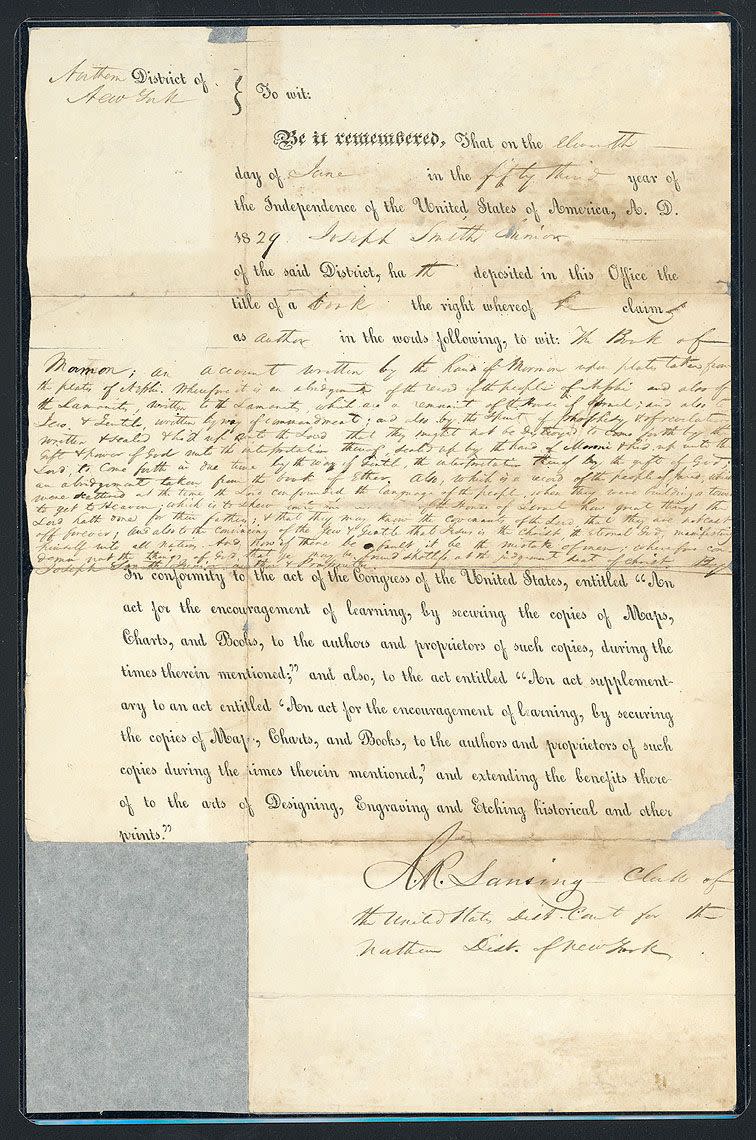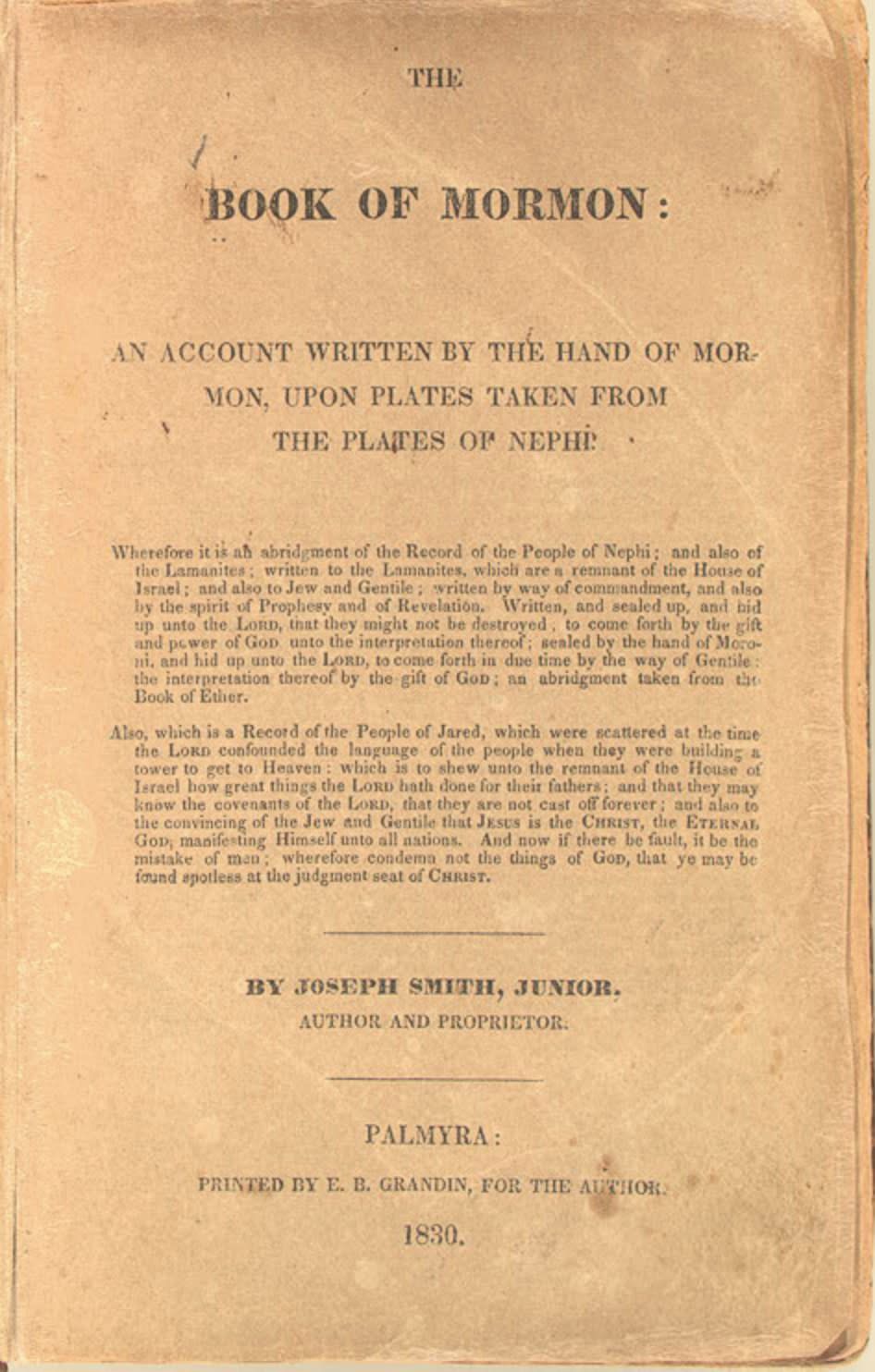How a Book of Mormon copyright dispute almost led to a fist fight

- Oops!Something went wrong.Please try again later.
- Oops!Something went wrong.Please try again later.
- Oops!Something went wrong.Please try again later.
- Oops!Something went wrong.Please try again later.
- Oops!Something went wrong.Please try again later.
This article was first published in the ChurchBeat newsletter. Sign up to receive the newsletter in your inbox each Wednesday night.
Joseph Smith was forced to defend the copyright for the Book of Mormon before it was even published. His defense was a legal one, though his opponent offered to settle the matter with hand-to-hand combat.
The focus of Latter-day Saint weekly worship services for Sunday School and other classes in 2024 returns to the Book of Mormon as part of a four-year rotation of emphasis between it, the Old and New Testaments, and the Doctrine & Covenants/Pearl of Great Price.
Members will study it together, individually and in their families through the “Come, Follow Me” curriculum published by the church.
Today, the chapter headings and footnotes and other additional information in the Book of Mormon published by the church are protected by copyright, but the Book of Mormon itself is now in the public domain.
But for a few weeks at the start of 1830, a copyright contest developed and pitted Joseph, his brother Hyrum and his scribe Oliver Cowdery against a newspaper publisher and former justice of the peace, Abner Cole, according to a biography of Joseph written by his mother.
Joseph completed the translation of the Book of Mormon in the summer of 1829, and on June 11, 1829, he deposited the title page with the clerk of the Northern District Court of New York. He paid $1.20 to file for a copyright and to receive a copy of it.
On June 26, the title page was published in the Wayne Sentinel, a newspaper in Palmyra, New York. The printing of the Book of Mormon began in August, and in October, Joseph wrote to Oliver.
“There begins to be a great call for our books in this country,” he wrote. “The minds of the people are very much excited when they find that there is a copyright obtained and that there is really a book about to be produced.”
But Cole, who published his newspaper on the same press that was printing the Book of Mormon, began to steal some of the text and print it in his publication, the Reflector.
On Jan. 2, 1830, more than two months before the Book of Mormon was published, Cole published its entire first chapter and the first three verses of the second chapter in his newspaper.
Hyrum and Oliver caught Cole in the act on a Sunday. The press was being used Monday through Saturday to print the Book of Mormon. Cole used it on Sunday to print the Reflector. Hyrum told Cole that Joseph had obtained a copyright, but Cole said he would continue to print excerpts.
Joseph and Hyrum’s father, Joseph Smith Sr., recognized a crisis and traveled to Harmony, Pennsylvania, to inform his son of the copyright infringement.
When Joseph returned to Palmyra and confronted Cole at Egbert B. Grandin’s print shop the following Sunday, he reiterated that he had a copyright and that Cole must stop.
Lucy Mack Smith, Joseph’s mother, reported that Cole threw down his coat, rolled up his sleeves and smacked his fists together.
“Do you want to fight, sir?” Cole said. “Do you want to fight?”
Joseph declined.
“There is law, and you will find that out, if you do not understand it,” he said to the trained lawyer.
Cole agreed to legal arbitration. He did publish excerpts from the Book of Mormon again on Jan. 13 and Jan. 22, 1830, but the arbitrator ruled Joseph did have a copyright to the Book of Mormon, and Cole ceased printing what belonged to Joseph under U.S. copyright law.
The court clerk later deposited the copyright in the Library of Congress, where it appeared in the “The Worlds of Joseph Smith” exhibit in 2005 with its accompanying printer’s proof sheet of the title page of the Book of Mormon, “which experts tell us is the actual first printed document in Mormon history,” said James Billington, the librarian of the Library of Congress.
You can read more about the Cole copyright crisis here, in Lucy Mack Smith’s book “History of Joseph Smith By His Mother Lucy Mack Smith” and in “Joseph Smith: Rough Stone Rolling,” by Richard Bushman.
Another Book of Mormon copyright crisis developed in England in 1840. You can read that compelling story of a race against time here.
My recent stories
Latter-day Saint leaders hire new managing director for Church Communication (Jan. 9)
Latter-day Saint leaders ‘deeply saddened’ by Japan earthquakes and urge people to remain alert (Jan. 4)
About the church
See the list of new mission presidents and companions called to serve in 2024.
The church released renderings for three new temples in California and Brazil.
Here’s a look at what church leaders have taught about goal setting.
Latter-day Saints have significantly fewer student loans, according to national survey.
BYU-Idaho president encourages students to develop “eulogy virtues.”
BYU president opens semester by talking to students about “becoming” and “doing” through a gospel lens.
Open-house reservations are available for the Red Cliffs Utah Temple in St. George.
A Latter-day Saint returned missionary played a role in Michigan winning the college football national championship.
What I’m reading
A man was sentenced last week for his role in a 2022 shootout near the Idaho Falls, Idaho Temple.
A Utah man was arrested in connection with at least 10 church burglaries.
Latter-day Saint and former Navy coach Ken Niumatalolo accepts new job at UCLA. Congratulations, Ken!
NBA players say dunking hurts. Why players hate — and love — to dunk. (Paywall)
Behind the scenes

The 1829 copyright for the Book of Mormon says:
“Northern District of New York)
“Be it remembered, that on the Eleventh day of June in the fifty third year of the Independence of the United States of America, A. D. 1829 Joseph Smith Junior of the said District, hath deposited in this Office the title of a book the right whereof he claims as author in the words following, to wit: 1 The Book of Mormon; an account written by the hand of Mormon upon plates taken from the plates of Nephi. ...”
The rest of the Book of Mormon title page is written on the copyright form. The form is signed by Richard R. Lansing, clerk of the United States District Court for the Northern District of New York. Read more at the Joseph Smith Papers.


